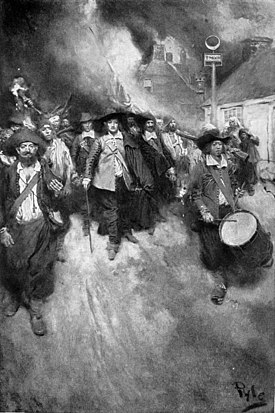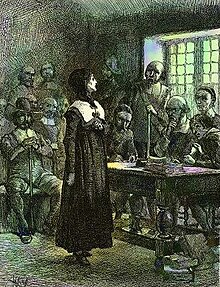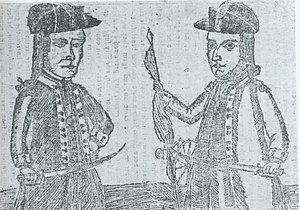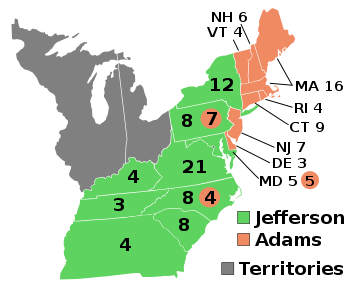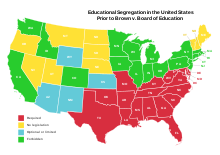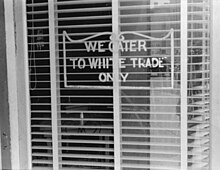|
Part 1 Birth of a
Republic The Jamestown colony had floundered until 1611 when tobacco was introduced to meet growing European demand. Crops were worked by indentured servants. In 1619 Jamestown decided to be governed by a representative democracy. Also two groups of slaves arrived and they were quickly integrated into the economy. The number of slaves grew very slowly and their treatment was much like that of local indentured servants. By the 1660's freed and existing slaves were becoming numerous enough to be competition for non-slave poor workers. They were also creating other domestic problems making large planters unhappy. This anxiety resulted in laws which removed freedoms from both existing and new slaves. hypercritical.
|
A 1662 Virginia law made children of enslaved women and white father a
slave whereas they had been free.
Bacon's
Rebellion of 1766 was caused by poor landowning recently freed
ind73entured servants and freed slaves paying taxes to
faraway Jamestown. They also formed an army to solve their
problems. Issues between Bacon's army and Jamestown developed.
Eventually about 1,000 rebels chased the Governor out of the capital.
"Government forces from England arrived soon after and spent several
years defeating pockets of resistance and reforming the colonial
government to one more directly under royal control." Slaves had once
been more expensive but fear of rebellions by indentured servants added
to the cost of hiring white and slaves thus became a cheaper source of
farm labor.
See
1. Brave New
World. |
| Freedom of Religion Began in 1636 When Massachusetts Expelled Roger Williams Roger Williams immigrated from England to Boston in 1631. He refused preaching/teacher work because as a Separatist he did not agree with Boston's less radical Puritans. He left for more Separatist oriented Salem caused Puritans unhappiness. He soon moved to Separatist Plymouth where he got along with the people and studied the Indian behavior. Eventually he preached ideas too unconventional for Plymouth and by 1633 he was back in Salem. Roger Williams preached separatism, denounce as blasphemous the King's claim to Indian land, denounced the Bay Colony's loyalty oath as sacrilegious and he denied the right of civil authority to punish violation of the first five commandments. They related to idolatry, Sabbath-breaking, profanity, dishonoring your parents, and blasphemy. Eventually he was convicted of sedition and heresy. Order to leave Williams took his time but fear of imprisonment forced a quick winter departure where the cold didn't get him because he was helped by his Indian knowledge. In 1836 he and his followers founded Providence where they signed a pact allowing government that |
|
|
All Immigrates Welcomed by 1654 New Amsterdam The Dutch West Easiest Company settlement of New Amsterdam grew rapidly and soon had 500 diverse inhabitants. They spoke eighteen languages. It was established for profit so anyone who worked was welcome. In 1643 twenty-three Jewish people arrived looking for work . They had been expelled from their Portuguese controlled South American Dutch Colony. Anti-Semitic Governor Peter |
Stuyvesant wrote Holland asking to exclude them because they were poor and too dependent. The Jews wrote their successful business friends in Holland asking for support with the Dutch West Indies Company. The company decided they could stay as long as they were not a burden. This was a symbolic turning point because most countries restricted immigrants to maintain their cultural, ethnic, and religious identity. There would be four |
 great foreign
immigrants waves and while assimilation was not easy, immigrant
culture eventual became an important part of our culture.
Assimilation is one of many contentious
questions that began when during the Colonial period and continues today.
Pizza anyone? Click to enlarge and watch a slide show. great foreign
immigrants waves and while assimilation was not easy, immigrant
culture eventual became an important part of our culture.
Assimilation is one of many contentious
questions that began when during the Colonial period and continues today.
Pizza anyone? Click to enlarge and watch a slide show. |
|
Freedom of the Press Began with the 1735 Zenger Trial In late 1733 The New York Weekly Journal publisher Peter Zenger began printing opinions critical of the corrupt British colonial governor William Cosby. A late 1734 arrest order was executed. An inappropriately large bale was set. Zenger's lawyers did not pay as they wanted to stir up publicity against the Governor and his friendly judge. Eventually Zenger was charged with seditious liability. The law required the jury only determine if the defendant had perpetrated the material. Things didn't look good as when the judge dismissed Peter's two lawyers and replaced them with a governor friendly lawyer. The short trial was about to end when a star Philadelphia defense lawyer took over. He agreed that his client had published the material but |
 he told the
jury they should acquit because true statements could not be libellee. The jury acquitted. While no precedent was set what did begin was a belief that liberty required freedom of the press and speech. The trial would be publicized and
soon state governors began acting more responsibly. It would take decades to determine the exact legalities of freedom of the press
and speech.
President Adams would pass Alien and Sedition Acts to stop an
adversarial press. Only a few were prosecuted though some were jailed.
The law
was repealed under President Jefferson. Freedom of the press and
speech issues during difficult periods would
continue to haunt leaders. he told the
jury they should acquit because true statements could not be libellee. The jury acquitted. While no precedent was set what did begin was a belief that liberty required freedom of the press and speech. The trial would be publicized and
soon state governors began acting more responsibly. It would take decades to determine the exact legalities of freedom of the press
and speech.
President Adams would pass Alien and Sedition Acts to stop an
adversarial press. Only a few were prosecuted though some were jailed.
The law
was repealed under President Jefferson. Freedom of the press and
speech issues during difficult periods would
continue to haunt leaders. |
|
Shays' 1786 Tax Rebellion Leads to a Constitution Farmers in western Massachusetts were having serious problems paying taxes after the state government began accepting only hard currency and not the worthless continental currency or farm goods. Farmers felt oppressed by a few elite eastern merchants and politicians who had set up the tax and legal systems to benefit themselves. Civil disobedience in the form of not allowing judges to foreclose on farm property began in August of 1886. It was the main tool used by the protesters. The Massachusetts Militia refused the governor's orders to control the disobedience. The purposely designed weak central government under Articles of Confederation was unable to raise a meaningful army. Sam Adams had been the most aggressive revolutionary leader when it came to English oppression but now he was a member of the establishment. He wanted harsh treatment including execution. The governor offered a few minor tax collection adjustments to help farmers. But he also passed the very harsh Riot Act which took away human rights and a Militia Act that allowed the |
exestuation of militia who refused to follow orders. Soon the governor began to raised a privately financed state militia. This caused a severe reaction by farmer who saw a private army is the first step on the road to tyranny. The farmers raised their own army led by revolutionary war veteran and militia member Daniel Shay. Their main battle was to be a surprise attack at the federal Springfield arsenal. It didn't work. The armory was unexpectedly defended by militia men who were quickly dispersed. Four rebels were killed. They regrouped but the new Governor's privately financed army led by Benjamin Lincoln arrived and dispersed them with a surprise attack. That was it. Rebellion over. Eventually there was an amnesty based on signing of a loyalty oath. Twenty-one leaders were order hung but only two got the rope. The governor lost reelection and the new governor was more sympathetic to the farmers and he pardoned Shay and the other leaders. In Philadelphia those in Congress who feared the rebellion of citizens and resulting anarchy wanted a strong central government so the May of 1887 Philadelphia Constitutional Convention was called. By September a constitution was written. Ratification followed in July of 1788 and the Bill of Rights followed in 1791. The founders wrote what is now the world's oldest written constitution. France was writing her first constitution and she is now on her seventeenth and counting.
|
Contemporary depiction of protest leaders Daniel Shays (left) and Job Shattuck.
Editors Note:
Massachusetts set up a tax and legal system to benefit business. Difficult
economic times after the revolution caused by an
almost worthless Continental Currency caused
many farmers to lose property to Easterners.
|
| Note: : textbooksfree.org summaries do little justice to the fascinating lectures available through Turning Points in American History audio course of E. T. O'Donnell |
PRESIDENTIAL
COURAGE1
Brave Leaders and How They Changed America
1789-1989 By Michael
Beschlos Fun Stuff Presidential Election Discussion Questions and Political Controversies examine poverty, middle income stagnation ... |
|
| George Washington Creates Executive Privilege A Virginia Republican ignored Washington's order to keep Jay Treaty content secrete and passed a copy to the French who helped make it public. Hamilton's treaty defense in front of the New York City Hall had him stoned crating a bloody face. In Boston a British ship was set aflame. Source Washington's use of Executive Privilege to keep Jay Treaty information from Congress was the first of many such Presidential attempts. Richard Nixon attempt may be the most notorious. The result was our First Party System. Hamilton's use of Implied Powers to defend the constitutionality of the First Bank of the United States was one of Washington's turning points. Chief Justice John Marshall first used it in McCulloch v. Maryland. |
The Politics: "A speedy Death to General Washington!" cartoon was one of many. It depicted the President being chased out of town by those who felt the unconstitutional treaty was reason for impeachment. The South not being compensated for freed slaves who had fought for England was one reason for unhappiness. Secretary of State Hamilton wanted to negotiate but his friendship with England ruled him out. Supreme Court Chief Justice Jay was sent. Soon to be a Republican, Jay was far from being a loyal cabinet member. See Leader of the Opposition: In Wait at Monticello from Thomas Jefferson: The Art of Power, 2012 by J. Meacham and U. S. History Hamilton vs. Jefferson. Cartoon source |
| Jackson's New Use for a Presidential Veto "Before Independence Day 1832 the Senate and House voted to renew the charter of the Second Bank of the "United State." Most of Jackson's cabinet was against a clash with Bank President Biddle so Jackson got help from his wordsmith-tactician Amos Kendall to help with the fight. Amos became a member of what became known as the President's "Kitchen Cabinet" and drafted most of Jackson's hellfire message that vetoed the Bank's renewal. Jackson's veto was sustained. Source | The Politics: Few Presidents before Jackson had vetoed bills and he was the first to do so simply because he did not like it. Neither Chamber got the two-thirds votes necessary to overturn Jackson's veto. Biddle "flung open the cash draws" to stop the President's 1832 reelection but Jackson and Van Buren's 55% of the vote easily beat Clay. As Jackson predicted, Clay would not do well west of the mountains and south of the Potomac where Clay only won home state Kentucky. |
|
1800 Sees First Peaceful Democratic Power Transfer Republican ideology of the late 18th century believed political parties were detrimental to society because they served vested interests. A nonpartisan elite would best serve the Republic but differences and party politics developed. Thomas Pain wondered if Washington was a traitor or an imposter. Federalist Adams won the 1796 election and the constitution indicated second place finisher Jefferson was Vice President. The two friends had different political beliefs and would not get along .A key differences between the two was diplomatic relations with England and France. Federalist loved Britan and idealized their government. They felt the U.S. was too weak to get involved with the intense war between the two countries. They also hated the French because of the anarchy that had resulted after the French Revolution. Jefferson's group had strong Republican beliefs and soon were called Republicans. They felt the Federalist wanted to turn the fledgling Republic into a Monarchy plus and they wanted to help our revolutionary war ally France. Federalist believed in a strong central government as demonstrated by the Washington's assumption of state revolutionary war debt even though some states had already paid their debt. They also formed the Bank of the U.S and generated revenue with a new tariff. Both helped the Northeast industry much more than Southern agriculture. Republicans lived in mostly rural states. They felt these actions endangered the Republic. They wanted a weak central government that did not need revenue and they didn't like the eastern bankers or their tariffs. They wanted states rights. Source See Conservatism vs. Progressivism |
The 1800 Presidential Election was very rancorous because no rules of acceptable behavior existed and politics could be a messy business. The Aurora of Philadelphia became the mouthpiece of the Jeffersonian Republicans. They printed that Adams was a Monarchist who would appoint himself King. His son would be the hereditary successor. They said Adams had ordered a boatload of prostates delivered from England to meat his lustful passions. The Porcupine Gazette did the same for the Federalists. They printed Jefferson was an atheist and anarchists. Two mistakes hurt Adams. In 1798 he had created a standing army and enlarged the Navy. This hurt because traditional Republican orthodoxy preached that a standing army always led to a dictator. A citizen soldier was enough to meet emergencies. Second, the Alien and Sedition Acts hurt on two fronts. Immigrants didn't like the Alien Act which made them wait longer for citizenship and allowed them to be arrested and even deported. The Sedition Act made Republican written anti- government literature illegal. This would be the first of many such instances where the President's would abuse the Constitution in |
the name of national security. The election ended in an Electoral College tie. Receiving votes were two Federalists , Adams( 65) and Thomas Pickney(64) plus two Republicans Jefferson(73) and Aaron Burr(73), John Jay had one vote. The election went to the House of Representing. Hamilton worked behind the scenes for Jefferson who he felt was less-dangerous than Burr. The runoff was tied for 36 ballots and finally on number 37 Jefferson was declared the winner. The U.S. became the first society to followed a revolution with a peacefully transfer of power. In his Inaugural Jefferson said "We are all Federalists, We are all Republicans." This assured a more peaceful power transfers. Two interesting side-note. VP Burr later killed former Treasury Secretary Hamilton in a dual. Former friends Adams and Jefferson became bitter enemies because of partisan politics and didn't communicate until 1812 when letters between the two healed the damage. Letters continued until their death on the same day of 7/4/26, the 50th anniversary of the nation's birth. |
Federalist and Republican House quarrel. Foreign influence on Domestic Politics |
|
|
|
Marshal Creates a Third Separate Power Of all a President's powers, many feel the appointment of a Supreme Court justice is most important. The Federalist lost power in 1800 and feared new administration anarchy and tried to decrease the new President's power so under President Adams they decided to control the federal judiciary. First Adams appointed John Marshall as Supreme Court Chief Justice. Then the Federalist congress passed a law that decreased the number of justices from 7 to 5 and increased the number of Federal Judgeships. Adams dutifully appoint the new justices with the last group appointed the night he left office. The 42 appointments were left signed and sealed but undelivered by Chief Justice Marshall. Known as the infamous "Midnight Judges," Marshal felt signed and sealed meant appointed and the administration must mail the appointments. Source |
The Politics: Jefferson refused and issued 25 new appointments in their place. Marshal wanted his fellow justices to rule the 1801 Judiciary Act unconstitutional. The justices refused. Then Federalist appointee William Marbury sued for his appointment. He wanted the soon to be appointed be Secretary of State John Madison to send the mail. In Marbury v. Madison the court ruled that Marbury had a right to the commission and that the law provided Marbury with the correct legal remedy. Nonetheless the Court stopped short of ordering Madison (by writ of mandamus) to hand over Marbury's commission. |
Instead it held that the provision of the Judiciary Act of 1789 that enabled Marbury to bring his claim to the Supreme Court was itself unconstitutional since it purported to extend the Court's original jurisdiction beyond that which Article III had established. Over the years legal scholars have decided what Marshal did was a stretch at best but the deed was done. Madison felt adding to the court's power was more important than the short term political gain of his Federalist Party. The concept of Judicial Review would spread throughout the world. See FDR Court-packing of 1937. |
|
|
Who Are We of We the People? At the dawn of the American Revolution about 60% of the white males (and their oldest son) could vote provided they owned a reasonable amount of real property or personal property. Republican government needed people who had a stake in society, a vested interest in a stable society and who wanted low taxes. No poor would be allowed to vote themselves money from the wealthy. Democracy was mob rule. Residency was also required in many states and some excluded Catholics and Jews. Property owning women, free African Americans, and Indians were allowed in a few states. |
After the Revolution payment of taxes and being in the militia or army were added to the list of conditions. Most states eliminated religious tests. Maryland, North. Carolina and three other states allowed free blacks to vote. We were founded as a Representative Republic where some and not all had control. The constitution had left voting to the states. Westward expansion led to new states and their leaders wanted economic prosperity and high congressional representation. Both required people who could vote. Vermont was the first state to adjust when in 1791 she allowed all white males to vote. Only Kentucky followed in 1792. In 1817 Indiana started a movement toward universal white male suffrage and many states quickly followed. Source |
 |
|
|
|
Provided by http://www.textbooksfree.org See Economic Issues from One-Page Class Handouts |
||||



